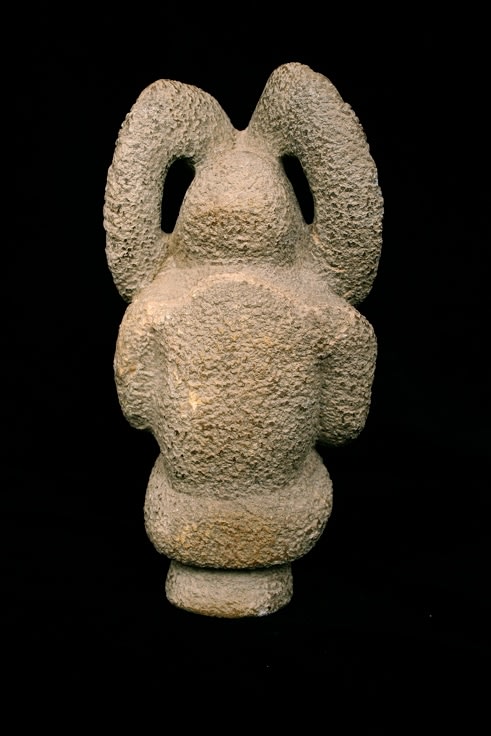Kissi Soapstone Nomoli Sculpture of a Seated Figure, 12th Century CE - 18th Century CE
Stone
4.75 x 12
DZ.004
The Kissi are strictly a language group that is spread across modern Sierra Leone, and includes other tribes such as the Bassa, Sapi, Temne, Toma and Grebo. The group, which...
The Kissi are strictly a language group that is spread across modern Sierra Leone, and includes other tribes such as the Bassa, Sapi, Temne, Toma and Grebo. The group, which technically also includes the Mende tribe, is known in art-history circles as the Sapi-Grebo. The Sapi kingdom used to include some of these tribes, but was subsumed under the Manes people in the 16th century. They, the Mende and the Sapi all have different ways of dealing with these figures when they appear, although they are important for each tribe. The modern tribes are mainly rice farmers, with vegetable gardens and some livestock (notably cows, which are considered as sacred, and reserved for sacrifices). Villages tend to be small, and run by members of the Poro society; a system of gerontocracy is also in operation. Most of the Kissi have converted to Christianity, but a notable proportion adhere to traditional belief that are centred around Pombo, Mahen Yafe and Nomoli figures, which are dug up in the fields and revered as ancestors (Pombo – the generic name for these items – literally means “the deceased”) or “rice gods”.
As the items are typically out of their context, little is known of the way they were carved and used by their original societies. It has been claimed that they are a localised offshoot of early Portuguese incursions into the area (15th – 16th century), but there is little stylistic or historic basis in fact to support this assertion. The Sapi kingdom may also have been involved in making of some classes of figure. The major distinctions between the figure are that the Mahen Yafe are primarily heads adorned with unusual facial hair and jewellery, while the Pombo (as called by the Mende) figures have crested hairstyles and filed teeth. The Nomoli are very much as depicted by the current piece, although they are sometimes bearded. The only ray of data regarding age is a radiometric date on a rare wooden piece, which yielded a date between 1190 and 1394, although the fact this is an isolate, and without context, makes its validity questionable.
The role of these pieces is, as stated, uncertain. The more ornate ones probably represent chiefs, while the less anthropomorphic probably represent spirits. As there is no strong evidence to suggest that there was major population replacement, however, it is possible that the ancient populations were ancestral to modern Kissi groups, and that certain parallels can be drawn between them. The modern Kissi are highly superstitious, and live in fear of the supernatural. They have talismans to protect them from the unknown, and especially from witches. Their treatment of statues reflects this tendency. So it is possible that the figures, while far from their original context, are in fact being used much in the way that they were intended to be.
As the items are typically out of their context, little is known of the way they were carved and used by their original societies. It has been claimed that they are a localised offshoot of early Portuguese incursions into the area (15th – 16th century), but there is little stylistic or historic basis in fact to support this assertion. The Sapi kingdom may also have been involved in making of some classes of figure. The major distinctions between the figure are that the Mahen Yafe are primarily heads adorned with unusual facial hair and jewellery, while the Pombo (as called by the Mende) figures have crested hairstyles and filed teeth. The Nomoli are very much as depicted by the current piece, although they are sometimes bearded. The only ray of data regarding age is a radiometric date on a rare wooden piece, which yielded a date between 1190 and 1394, although the fact this is an isolate, and without context, makes its validity questionable.
The role of these pieces is, as stated, uncertain. The more ornate ones probably represent chiefs, while the less anthropomorphic probably represent spirits. As there is no strong evidence to suggest that there was major population replacement, however, it is possible that the ancient populations were ancestral to modern Kissi groups, and that certain parallels can be drawn between them. The modern Kissi are highly superstitious, and live in fear of the supernatural. They have talismans to protect them from the unknown, and especially from witches. Their treatment of statues reflects this tendency. So it is possible that the figures, while far from their original context, are in fact being used much in the way that they were intended to be.
